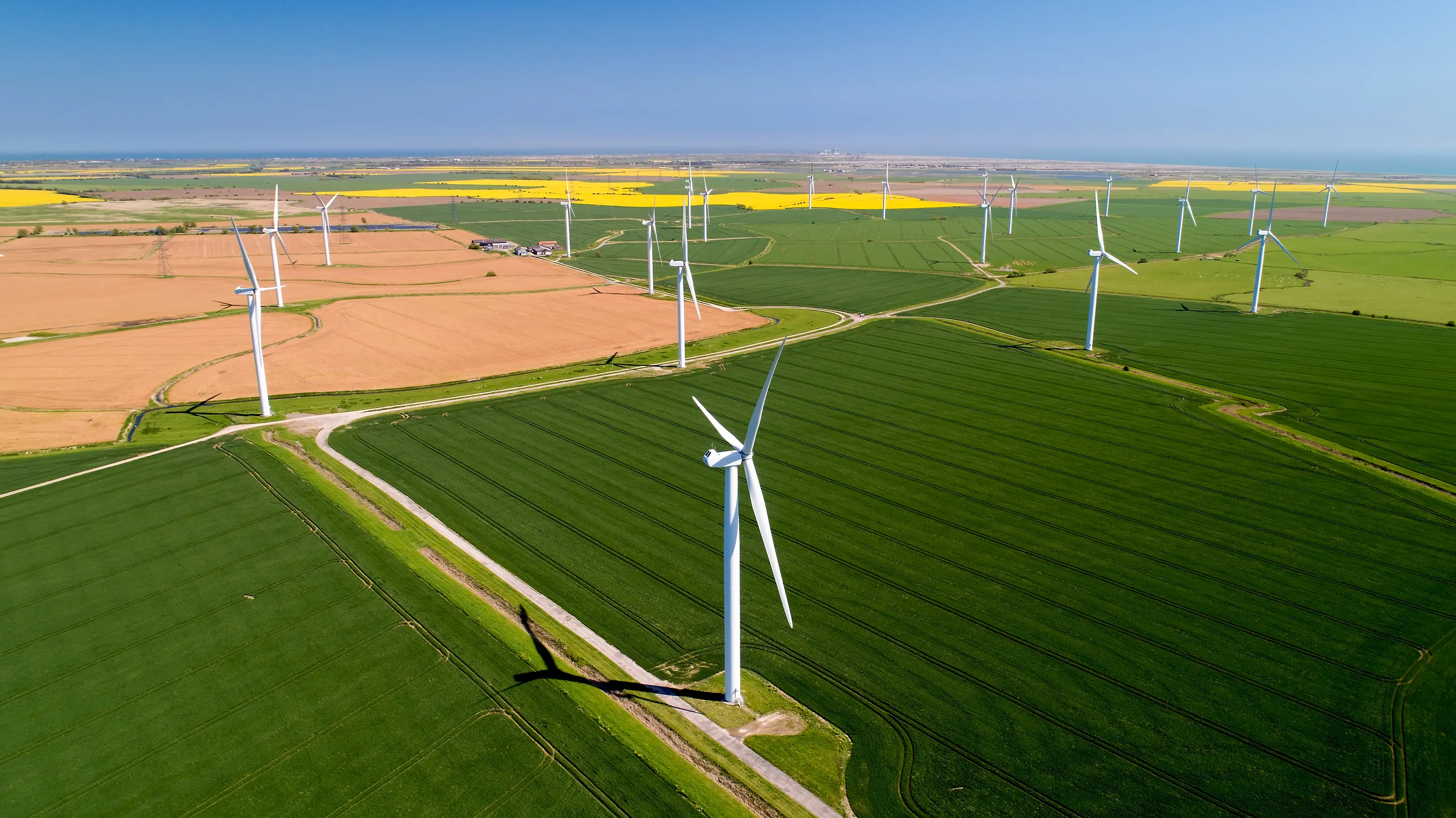Daniel Sutherland, EnergyPulse Analyst
18/08/2025 | 6 mins | EnergyPulse



From policy shift to project pipeline: assessing the impact of planning reforms on onshore wind in England
18 August 2025 - EnergyPulse blog
Restrictions on onshore wind projects in England were eased in July 2024 when the newly elected Labour Government reformed the National Planning Policy Framework [1,2]to end the de facto ban that had been in place since 2015. In practice, the previous restrictions meant that onshore wind projects in England could only proceed if located in a designated area in a local plan and faced no local objections—criteria so restrictive that even a single objection could block approval. Following the removal of these restrictions, onshore wind applications are now treated in the same way as other energy development proposals.
EnergyPulse has looked at trends in planning applications and approvals before and after the policy change, as well as regional variations, lead times and approval rates over time, to better understand the effect on the industry and look ahead to the future of onshore wind in the UK.
Related content
Overall trends
One year on from the lifting of restrictions around onshore wind planning applications in England, whilst we have noted a small increase in project submissions in the year since 8th June 2024 compared to the previous yearly average (Figure 1.1), it is important that the time taken to prepare a full planning application is considered.
Onshore wind projects in England |
8 June 2015 – 8 July 2024
|
8 July 2024 – 8 July 2025 (year since ban lifted) |
|
Submitted capacity (MW) |
27.0 |
16.9 |
|
Submitted number of projects |
9.9 |
16.0 |
|
Average capacity of projects Submitted (MW) |
2.8 |
1.1 |
Figure 1.1: Table summarising onshore wind planning applications in England during the de-facto ban (displaying the yearly average) and, in the year following the easing of restrictions. The restrictions came into effect 18 June 2015 [1] and were lifted 8 July 2024 [2]
Scout Moor II: a sign of momentum
Encouragingly we have researched that at least 6 projects greater than 20MW have entered the pipeline in the pre-application stage in the form or screening or scoping requests (Figure 1.2). These vary in size from 25MW to nearly 300MW and could amount to a total capacity of 642MW if all are approved and built.
Among these emerging projects is Scout Moor II, which has now formally submitted its planning application for approval. The proposal represents a major milestone as one of the first large-scale onshore wind projects to reach the application stage under the new planning rules.
If approved, it will generate up to 100MW of clean electricity, building on the legacy of the original Scout Moor Wind Farm and signalling a tangible return of larger onshore wind proposals to the English planning system.
Figure 1.2: Map showing the medium/large scale (>20MW) early-stage projects in England since 8 July 2024. The size of the data point represents the relative capacity of the project.
Planning timelines
When considering projects in early-stage development or those that have recently been submitted, we should take note of historic lead times for planning decisions (Figure 2.1). For projects less than 20MW in capacity, lead times varied between 2016 and 2021, but the trendline indicates an average of approximately just under one year. Larger projects (greater than 20MW capacity) show a trend of closer to two years for an initial planning decision. Taking this into account, we could see those developing projects in England (like Scout Moor II) receiving decisions as early as 2027/28.
-
Discover more trends in onshore wind in England
How can I access this data?
EnergyPulse stores and provides this data via RenewableUK membership or via subscription.
Figure 2.1: Line graph representing the average days from application submission to decision by the relevant planning authority in England for onshore wind projects from 2010 to 2025 for project greater than and less than 20MW in capacity. Data is limited for those projects greater than 20MW in capacity due to the lack of submissions in this category since 2017.
Approval rates
Our third area of focus is the approval rate of onshore wind projects. Figure 2.2 illustrates two trends: 1) the decrease in number of projects being determined and 2) the increase in the approval rate over time. We can see here that approvals since 2022 have picked up significantly, with all 10 projects (identified by EnergyPulse) approved in 2025 year-to-date . However, it is worth noting that a proportion of these projects since 2022 involve the replacement or repowering of existing turbines, or resubmissions of planning applications (58%). Also, 78% of the projects decided upon since 2022 have been single turbines.
Figure 2.2: Planning decisions by local planning authorities (LPA) in England by outcome since 2015 and the calculated approval rate vs all other decisions including withdrawals and non-determination. The graph does not include projects that may have gone to appeal.
It is evident that while the lifting of the de-facto ban has not brought about an immediate revival in onshore wind in England, the signs of renewed activity are clear. The submission of Scout Moor II, alongside others in early-stage development, suggests a slow but steady revival of onshore wind in England.
How to go further: the role of the Onshore Wind Taskforce
The Onshore Wind Taskforce Strategy [3], published by the Government in July sets out over 40 steps to accelerate onshore wind deployment rapidly throughout the UK, including installing up to 29 gigawatts (GW) by 2030. The strategy includes a chapter on updating and developing guidance and policy to support the deployment of onshore wind in England - crucial to building confidence and speeding up consenting.
Looking ahead to this year’s clean energy auction, Allocation Round 7, RenewableUK’s Head of Onshore Wind Delivery, James Robottom noted that “to achieve the Government’s clean power goal, Ministers will have to maximise the amount of new onshore wind capacity we secure in the next two annual auctions for contracts to generate clean power – these allocation rounds are mission-critical to enable us to reach that target”.
Onshore Wind Conference
To find out more about the onshore wind story in the UK, join us at Onshore Wind Conference 2025, taking place on 16 and 17 September in Edinburgh, co-organised by RenewableUK and Scottish Renewables. We’ll be providing hands on demonstrations of the EnergyPulse platform and how you can access and interrogate the data to better , as well as identify opportunities in the onshore wind industry.
This year, we’re showcasing our new Turbine Location dashboard, which maps individual turbine locations for UK wind projects that are operational, under construction, consented, or awaiting a decision. We’ll also be releasing our annual onshore wind report to coincide with the event, which is your go‑to briefing on the size, direction, and pace of the UK’s onshore wind sector — combining raw data with expert interpretation to guide industry stakeholders.
Onshore Wind Conference 2025
Meet us there
References
[1] House of Commons Hansard Ministerial Statements for 18 Jun 2015 (pt 0001)
[2] Policy statement on onshore wind - GOV.UK
Disclaimer
Data correct as of 30/07/2025
Data is accurate to the best of RenewableUK’s knowledge and is a high-level snapshot of the information available in the renewable energy database. Projections do not represent a RenewableUK position and should be used only as guides to possible outcomes. RenewableUK takes no responsibility for losses incurred by the use of this information.



